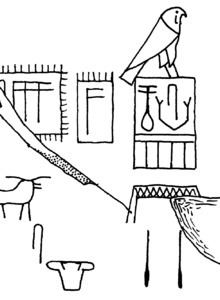 | ||
Reign short, ca. 2900 BC (end of 1st Dynasty) Successor unclear, possibly Hotepsekhemwy or Horus Bird | ||
Sneferka is the serekh-name of an early Egyptian king who may have ruled at the end of 1st dynasty. The exact length of his reign is unknown, but thought to have been very short and his chronological position is unclear.
Identity
Beside Sneferka's serekh, the inscriptions mention several institutions and places already known thanks to finds dating to Qa'a's reign. They are called Qau-Netjeru ("Elevations of the gods") and Ah-Netjer ("Divine palace") and appear in several stone vessel inscriptions from Qa'a's tomb at Abydos. Egyptologists such as Peter Kaplony conclude that the inscriptions prove a chronological adjacency to king Qa'a or that the name "Sneferka" was an alternative name that Qa'a bore for a short time.
Two artifacts of different origins show the serekh of a king, whose name is highly disputed, for the hieroglyphic sign used to write the king's name is almost illegible. Since at least the depiction of a bird was recognised, the king in question is called "Horus Bird". Egyptologists such as Wolfgang Helck and Peter Kaplony believe that Sneferka and "Horus Bird" fought each other to gain the throne of Egypt. The struggles peaked in the plundering of the royal cemetery of Abydos, which was therefore abandoned. The struggle for the throne was possibly brought to an end by the founder of the 2nd dynasty, king Hotepsekhemwy. An evidence supporting this theory is the Horus name of Hotepsekhemwy which means "The two powers are reconciled", and could relate to a re-unification of the Egyptian realm after a period of discord.
In contrast, Egyptologist Kim Ryholt believes that Sneferka ruled during the midst of 2nd dynasty and was to be identified with Neferkara I, attested in Ramesside sources. He points to the circumstance that Ramesside scribes often added the symbol of the sun to the names of early dynastic kings, ignoring the fact that the sun was not yet an object of divine adoration at that early time. To support his view, Ryholt points to cartouche names such as Neferkara II and Nebkara I, which represent early kings and contradictorily have a sun-symbol in their names. Egyptologist Aidan Dodson thinks alike and points to the fact, that nearly all serekhs of Sneferka are made "on erasures", thus leading to the conclusion that Sneferka usurped Qa'a's vessels. This behavior was typical for kings that ruled somewhat later than the original owner of the re-used artefacts and who ruled for a very short time only.
